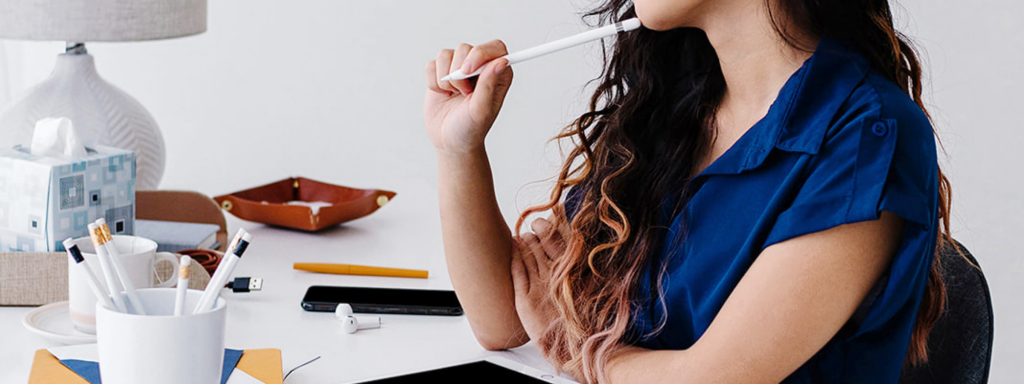
*Disclaimer: This post contains affiliate links. If you choose to make a purchase through one of my affiliate links, I will receive a commission at no additional cost to you. Thank you for your support!
If you want to get lots of eyes on your Pinterest pins, understanding and implementing Pinterest SEO is essential.
Pinterest SEO can seem confusing and seem overwhelming at first. However, this checklist will outline the top steps you need to take to optimize your Pinterest profile, boards, and pins.
Whether you’re new to Pinterest marketing or not, these Pinterest SEO tips will show you exactly how to do Pinterest SEO and will simply break down the process!
Let’s dive in.
Please note: Pinterest is always changing, and while I try my best to update my posts, not all information may be up to date. If you’re looking too see the most updated tips, strategies, and information, check out this resource page.
Want to print out this checklist or have it on-the-go? Fill out the form below and this checklist will be sent straight to your email inbox so it’s always accessible to you! (Plus, I include some valuable BONUS TIPS that have helped me see great results on multiple Pinterest accounts!)
What is Pinterest SEO?
Pinterest SEO is optimizing your Pinterest profile, boards, and pins with relevant and searchable keywords to get your pins to appear in Pinterest search results and other user’s home feeds.
In a nutshell, Pinterest SEO tells Pinterest exactly what a profile, board, or pin is about so the algorithm can then show it to an audience that may be interested in it.
Why is Pinterest SEO important?
Pinterest SEO is important because it helps Pinterest to rank and distribute your content to users on the platform.
The goal of Pinterest search results is to provide users with the most relevant pins to their search query. Likewise, the goal of Pinterest’s home feed is to show users pins that align with their interests.
When Pinterest fully understands what your pins are about, Pinterest is more likely to show your pins in these places, which are the two of the main places where pins are found, and this will in-turn help your Pinterest account and business to grow.
The ultimate Pinterest SEO checklist
There are 3 key parts of Pinterest SEO that are important for your Pinterest account:
- Pinterest profile SEO
- Pinterest board SEO
- Pinterest pin SEO
However, good Pinterest SEO is rooted in good Pinterest keyword research.
Without knowing how to find relevant, searchable, and popular keywords for your business, your pins will likely not perform as well.
Before you begin optimizing your Pinterest with Pinterest SEO, you need to find good keywords to optimize with.
Luckily, finding Pinterest keywords is not too difficult and there are many ways to find keywords right on Pinterest! This Pinterest keyword research guide will show you over 7 easy ways to find keywords easily on Pinterest.
Part 1: Pinterest profile SEO
Your Pinterest profile houses all of your boards and pins. Creating an optimized profile will help Pinterest understand what your content and business is about, which may help Pinterest to distribute your content where it is most relevant.
Here are the basic parts of an SEO optimized Pinterest profile:
1. Have a business account
One of the most important steps when it comes to Pinterest SEO is to create a free Pinterest business account.
A Pinterest business account will provide you important tools and analytics to help you track your growth and establish you as a business on Pinterest. As a business account, you will likely have more authority than a non-business (personal) account.
For your business, it’s important to create a new business account and NOT convert an old personal account. Starting fresh and optimizing your account from the very beginning is better than converting an old and un-optimized account.
Also, make sure that your business account is used strictly for business purposes. If you wish to use Pinterest for personal use, it’s best to create a separate personal account for non-business use.
Related: Should You Have A Personal Or Business Pinterest Account?
2. Choosing a niche
Although having a niche is not completely necessary, having a niche helps Pinterest to better understand exactly what your content is about and what you’re an expert in.
If you have a niche (or multiple niches) on Pinterest, keep all of your created and saved content related to that niche. Sticking to one or a few topics can help Pinterest to distribute your content to users interested in that content.
For example, if you are in the gardening niche, creating and saving gardening pins to only gardening related boards will help Pinterest understand that your content is connected to gardening. Pinterest may use this information to show your pins to other users that are also interested in gardening.
Like I said, you don’t need to select one niche. There are many successful multi-niche and lifestyle users. However, having a niche or general topic you cover can have its benefits.
Related: 35+ Best And Most Popular Pinterest Niches
3. Profile display name
Your display name on Pinterest is the perfect place to squeeze in some keywords.
Not only is this good for telling Pinterest who you are and what your content is about, but it’s also good for users who come across your profile!
The display name is also what can help your account be suggested to users in Pinterest search. (And if you rank there, you can gain a lot of followers from that!)
Think of your display name as your “introduction” to other users. Since the display name is in a large font, it’s often one of the first things seen when someone clicks on a profile.
Here are some questions to think about:
- Who are you and what do you have to offer?
- What are you an expert in?
- What is your content about? What is your niche?
- What is your business name?
You have a maximum of 65 characters to write your display name, so you’ll have to keep it short and sweet!
While everyone chooses to write theirs differently, most users choose to include at least one of the following:
- Business name
- Their name
- Keywords about their content, job, or niche
Here’s an example on Harman from Your Girl Knows‘s Pinterest account:
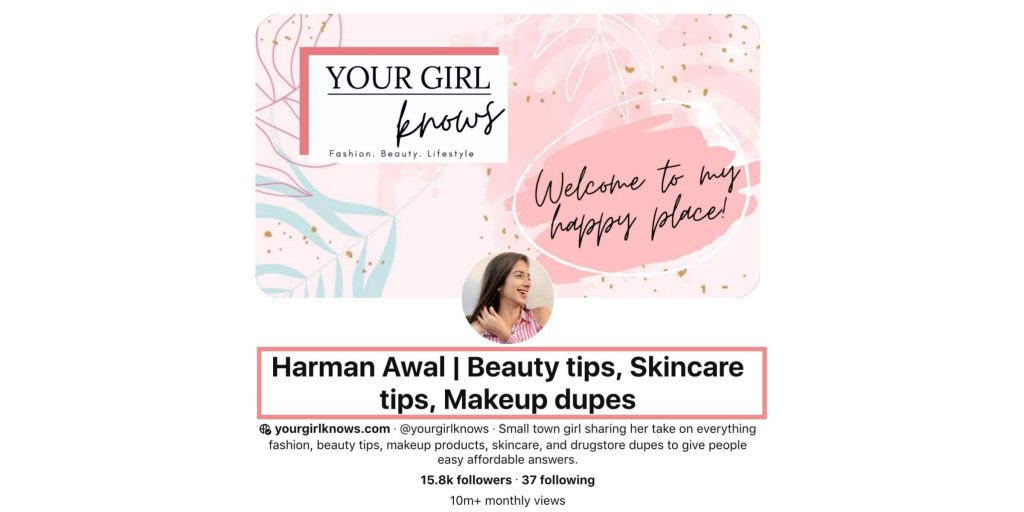
And another example on Rachel from Rachel Phipps‘s Pinterest account:
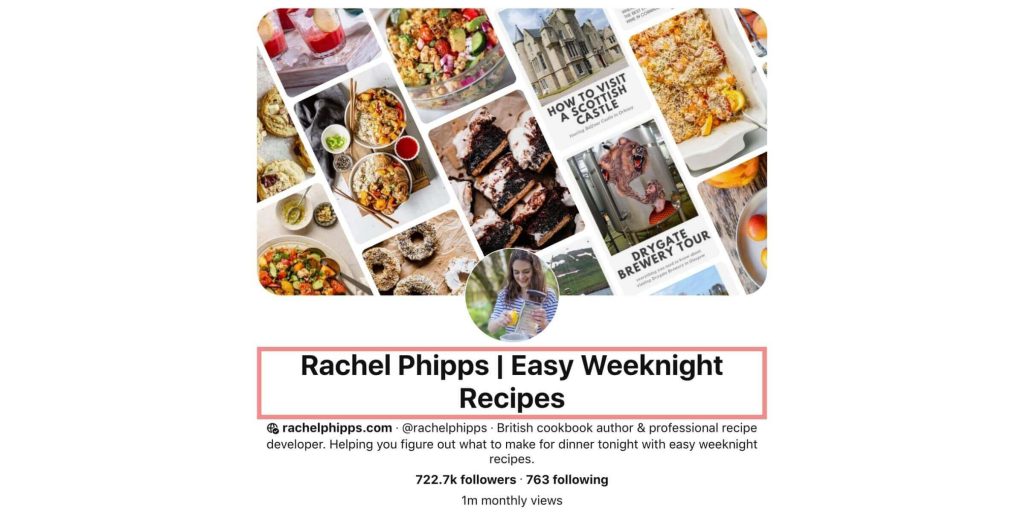
4. Profile description
While the display name is like the first “introduction,” the profile description is to go more in-depth on exactly what your business is about and what you offer.
This is another great place to squeeze in some keywords while telling Pinterest and other users who you are and what your content is about.
It’s important to keep your profile description in a sentence-like structure and not to keyword-stuff. It’s best to make it easy to read and keep it to the point. Cramming in keywords in an unnatural way can seem spam-like to Pinterest.
Here’s a great example of a profile description on Sophia from By Sophia Lee‘s Pinterest account.
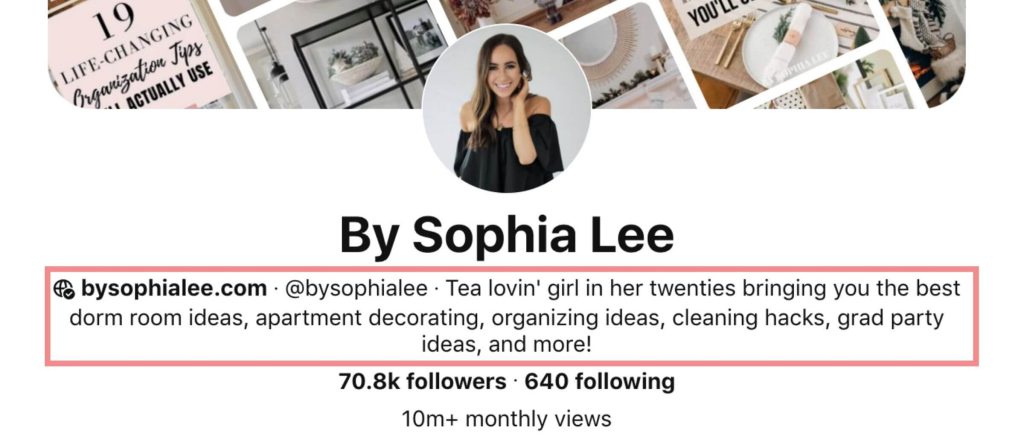
Some users even suggest including a link to a freebie or course that you offer to your audience. (However, be careful using URL shorteners like bit.ly as Pinterest is not a huge fan of these.)
Take a look at Ana from The She Approach:
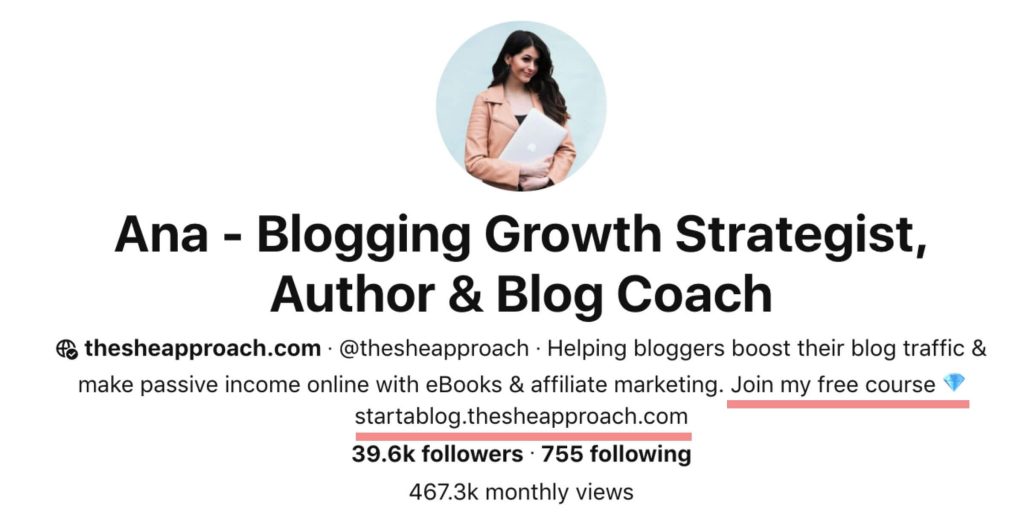
5. Profile picture
Profile pictures may not directly impact your SEO, but I 100% believe they play a large role in the conversion of users into followers.
When choosing a profile picture, I suggest you choose either:
- Your brand logo
- A picture of yourself
If you are the face behind your brand, showing your face is always great for connecting with your audience.
Did you know that on Instagram, users who show their faces are more likely to get more engagements?
An article by Content Savvy gives many reasons for this, such as:
- It’s great for brand recognition.
- It humanises your brand.
- It builds trust.
Showing your face to your audience can help to build authority and trust with them, which are both important for running a profitable business!
The same is true for Pinterest.
If you choose to use a photo of yourself, try to make sure it’s a light, high-quality photo where users can clearly see your face.
A professional-looking profile is much more likely to convert to followers, sales, page views, or more than one that looks low-quality!
6. Username
This tip is definitely not essential, but it doesn’t hurt to mention.
If you can, try to include a keyword from your business in your username.
For example, my Pinterest username is @leahmariemarketing. Since my content is about Pinterest marketing, this may help Pinterest to better understand what my account and content are about.
Your username should be based on your business or website name. If it includes a keyword in it, then great. But if not, don’t worry about it!
Accounts can be extremely successful without that, and many users also choose to just use their name, too. Your name can be your brand!
7. Website URL
Make sure you have a website on your Pinterest profile page. This allows users who come across your profile to click on that link and go to the URL destination. This is great when you’re trying to get page views, sell a product, make affiliate sales, and more.
Similar to your Pinterest username, including a keyword in your website URL (which will most likely be linked to many of your pins) may help Pinterest to better understand your account.
Again, this is not completely necessary, and you can see great results without doing this. But, if you have yet to create your website, it may be a good thing to keep in mind.
Some users who don’t have a website choose to link to other sites such as Instagram, YouTube, Etsy, Linktree, and more. If you choose that instead, that’s also completely fine!
8. Website claim
If you can, it’s very important to claim your website on Pinterest!
This process can be slightly technical, so here’s a super easy tutorial on how to do it.
When a website is claimed, a sphere with a check will appear next to the URL on your profile, which looks like this:

When users come across this, they’ll be able to tell that your website is legit and that you’re the real owner of it.
Claiming your website is important because:
- You can directly see how pins linked to your site are performing
- You can enable rich pins
- Pins saved from your website will be associated to your profile (which you definitely want if one of them goes viral!)
If you choose to link alternative websites such as Instagram, YouTube, Etsy, Linktree, or anything other than your own website, you will not be able to claim these websites.
While some Pinterest marketers say that pins linked to a claimed domain perform better, you can see see great results without having a claimed website on Pinterest.
9. Claim social media accounts
Update October 2022: Pinterest no longer gives you the ability to claim your Instagram, Etsy, or YouTube. You can still link pins to these platforms, but you don’t have the ability to claim them. Pinterest is now focused on merchants and helping sellers to connect their shops to Pinterest.
Be careful when linking to other platforms. Many users have noticed that Pinterest limits the distribution of pins linking to other platforms like Instagram.
Related: Should You Link Your Pinterest Pins To Instagram?
10. Enable rich pins
Enabling rich pins is another extremely important part of your Pinterest account because it can improve user experience and increase your engagement.
There are many great benefits to having rich pins enabled. Some include:
- They stand out much more in the feeds.
- Your pins are automatically updated when you update information on your website.
- They boost user experience by providing more information about an article, recipe, or product.
- They can help to increase conversion rates.
- It helps with brand visibility by adding your brand profile picture and name next to pins.
You can learn more about rich pins and their benefits in this article.
Setting up rich pins requires a bit of work on the technical side. (But, it’s not too tedious.)
Here’s a good step-by-step tutorial to help you quickly activate them.
Note: You will only be able to enable rich pins if you are able to claim your website URL.
There are 3 different types of rich pins, so make sure you enable the correct kind for your website or business.
- Article rich pins (In most cases, this is the best option for bloggers)
- Recipe rich pins
- Product rich pins
If you want to scale your growth on Pinterest, I highly suggest activating rich pins.
11. Who you follow
This is another thing that may help Pinterest to better understand what your account is about.
I always suggest finding and following accounts that are in your own niche. It’s just another way to narrow in on exactly what your Pinterest account’s niche is!
Part 2: Pinterest board SEO
Board SEO can be easily overlooked but it’s so important! Arguably, it may be one of the most important parts of Pinterest SEO.
Here’s how to optimize your Pinterest boards for Pinterest SEO:
12. Board title
Board titles should be a few words long and be a searchable keyword in your niche. It should also explain what the entire board and the content on it is in a nutshell.
All of your boards and their titles should be related to your niche(s). As previously mentioned, more personal boards should be on a personal account — not your business account.
It is important to avoid cutesy board title names that Pinterest won’t understand. (Like “baby fever” instead of “trendy newborn clothing.”)
For example, a food blogger’s Pinterest may have boards like:
- Family dinner recipes
- Healthy breakfast recipes
- School lunch recipes for kids
13. Board description
Creating a keyword-rich description is essential to boost the reach of your pins.
With 500 characters and solid keyword research, you should aim to fill as much as you can and include as many relevant keywords as possible in multiple sentences.
Tell Pinterest exactly what your board and the content on it is about!
Here’s an example of how you can use multiple keywords in a board description:
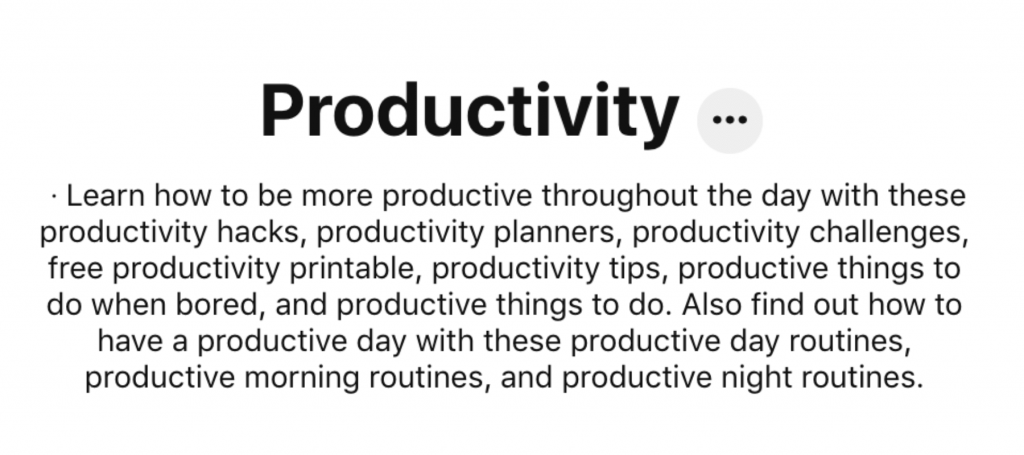
14. Pin relevant pins
The pins that you pin to each board matter.
Boards group similar pins together, so when you pin something to a board, Pinterest associates that pin with all of the other pins on it.
You want to make sure you pin the most relevant and high-quality pins to each board so Pinterest knows exactly what each board and pin is about.
So whenever you go to pin something, make sure you evaluate what board is the perfect fit for it.
Part 3: Pinterest pin SEO
Pins are the most important part of Pinterest. It’s what Pinterest is made up of, and they’re what drives in the page views, clients, followers, affiliate sales, and product sales.
So, you want to make sure your pins are found as often as possible.
The key to this is optimizing your pins for SEO so that Pinterest understands them and distributes them to an engaging and interested audience.
Here’s how to fully optimize your pins:
15. Create searchable or popular content
This doesn’t directly effect Pinterest SEO, but it definitely plays a huge role on how your pins will perform and how users will engage with them. Engagements are a huge part of Pinterest SEO — good engagement rates mean that pins will be distributed more into home feeds and ranked more in searches.
In order to get engagements, you need to create content that Pinterest users are interested in and want.
Does your content have an audience on Pinterest? Is it something people are interested in, or will it just sit there and get stranded in a sea of millions of pins?
The first step to creating pins and content is knowing if it will perform well on Pinterest.
Luckily, doing some keyword research and looking at Pinterest demographics should help you to determine this.
You want to know whether there’s potential for your content to perform well on Pinterest, or else you may just be wasting your time.
16. Optimal pin sizes
Having an optimal pin size is crucial to pin success. Vertical pins are what perform best on Pinterest. Square pins and horizontal pins often do not perform as well.
In fact, Pinterest even says:
“Other ratios may cause your Pin to truncate, or may negatively impact performance.”
Pinterest says in their creative best practices that pins should be vertical and have a 2:3 aspect ratio. Pinterest also says the image size should be no less than 600 x 900 pixels.
My favorite pin size is 1000 x 1500 pixels. I occasionally experiment with others, such as 1000 x 1750 pixels.
17. Pin title
The pin title should tell Pinterest exactly what the pin (or rather, the destination of the pin) is about and include keywords relevant to the content.
What value are you providing? What question are you answering? What is the pin about? What will users find on the other side of the link?
18. Pin description
Having a key-word rich description is one of the most important parts of an optimized pin.
The 500 character description is a great place to include lots of relevant keywords that will help Pinterest to understand exactly what the pin is about. Each description should aim to use multiple keywords in one or more complete sentences.
Here’s a great example of a keyword-rich pin description:
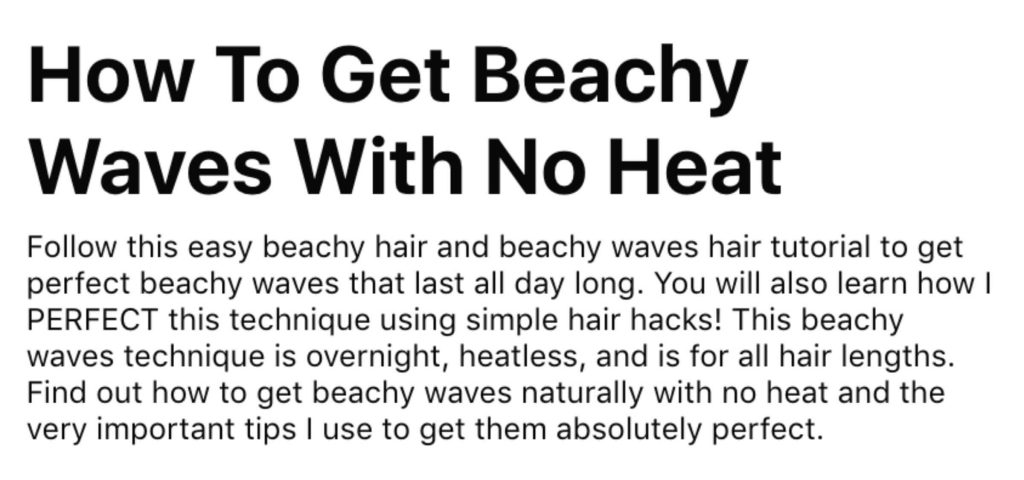
19. Saving new pins
As noted above, it really matters where you save your pins.
New Pinterest pins should be saved to the most relevant (and SEO optimized) board.
Whether or not group boards are still beneficial has been a somewhat controversial topic. However, they definitely aren’t as effective as they used to, so I recommend sticking to your own optimized boards (at least for the most part).
20. Alt text
I always say to include keywords wherever Pinterest gives you a chance to!
I usually add a short word or phrase with my keyword for the alt text. It may play a role in SEO, it may not, but I think it’s best to assume it does.
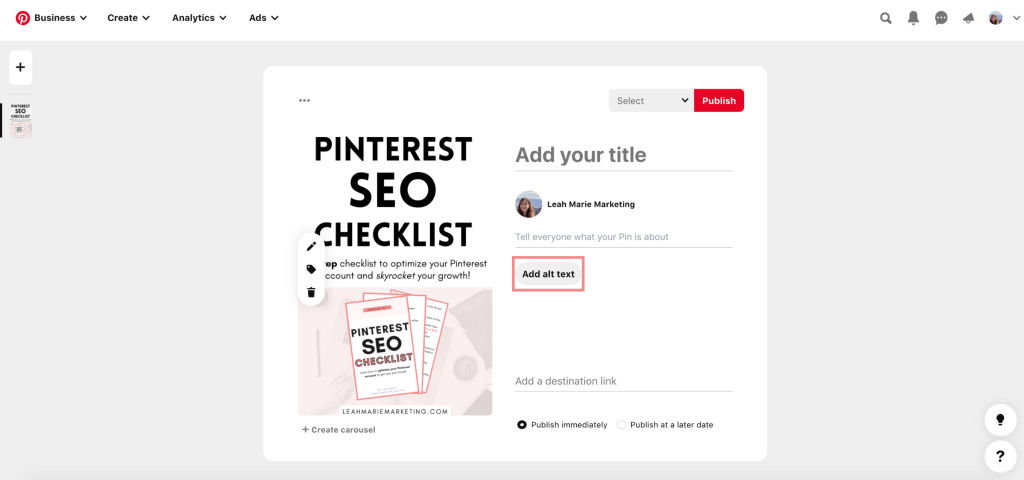
21. Pin image
Since Pinterest is a visual search engine, Pinterest can (literally) understand the images on your pin.
For example, if you have a picture of flowers on your pin, Pinterest will likely associate your pin with flowers.
How can you tell?
When you click on a pin and scroll down to “More like this,” many pins with similar visual features will appear.
Here’s an example of a Stitch cake from Disney’s “Lilo & Stitch.” When you scroll down to “More like this,” other Stitch cakes appear, and some other cakes that seem to fit the theme. (Notice that they’re all blue and purple, too!)

Sure, keywords can play a role with this too.
So, make sure you use images that are relevant to the topic of the pin. (If you have a pin about European cuisine, include pictures of food, not destinations in Europe!)
The best images to use on pins
And while on the topic of pins images, it’s important to note that many users report that pins using stock photos or personal photos perform better than pins using free stock images.
Many users use free stock photos, such as from Canva, but investing in paid stock photos may be the most beneficial for your business.
Some of my favorite stock photos are from Depositphotos. They have such a large library of images that you can find nearly whatever you are looking for to make your pin designs stellar!
Also, did you know that certain images help pins to perform better?
As mentioned by Buffer in this post, studies have found that some important elements of well-performing pin images are…
- Warmer colors (such as pink, red, and orange) compared to cooler colors (like blue, green, and purple)
- Lighter image compositions compared to darker images
So, take these things into consideration the next time you go to pin!
22. Pin text overlay
Believe it or not, Pinterest can supposedly READ the words on your pin!
Be intentional about the keywords and phrases you include on your pins images.
Making your main keywords large and bold may help, and it may also be best to refrain from using script fonts (at least for main keywords) that can be difficult to read.
In fact, sometimes it can be better for users to use less script font because if users can’t read the script, they are less likely to engage with your pin.
23. Pin file name
Some people claim that including your keywords in your pin file helps with SEO. While it may help, it likely doesn’t play a large role.
In all honesty, I often forget to do this, but if I remember, then I try to do it. When you name your pin files, try to remember this, but it is definitely not an end-all-be-all.
24. Website destination
The URL destination of your pins can impact your pins performance.
Pinterest’s creative best practices even says:
“If your Pin includes a link, check that the link is active and loads quickly. Your Pin’s creative tells people what to expect when they click. Make sure it matches your destination site’s topic and imagery.”
Make sure you don’t use broken links or links that take a very long time to load (as it makes for a bad user experience and may hurt the performance of your pin).
Also, a factor that helps pins to be distributed is long clicks. Pinterest defines long clicks as clicks that are 30 seconds or longer, which signals a positive user experience. Since Pinterest wants to give users the best user experience, these signals are favored in the algorithm and may help your pins to get seen more.
Many Pinterest users say that pinning the same URL too often if bad for SEO. While I’ve never had a personal issue with this, some users have reported that they have had issues, such as being caught in the spam filter.
Therefore, diversifying how often you pin URLs is a good idea. I created my Pinterest Pin Tracker to help with this. This simple and easy tracker helps you to keep track of what you pin, when you pin, and where you pin so you can be confident in your pinning! (Learn more here.)
25. Allow comments
Pinterest users will occasionally comment on your pins, and this is great engagement! Remember, you want all the positive engagement you can get.
Double-check that your pins allow comments to be posted on them. You don’t want to block your pins from this potential engagement, so make sure that you have commenting enabled!
Also, be sure to respond to comments. This can help build your relationship with your audience, and it may also lead to even more comments that continue the conversation, which means even more engagement!
26. Hashtags?
Using hashtags has been a debate on Pinterest for a while.
For a while, Pinterest promoted using hashtags. However, that stopped a while ago and Pinterest has hinted that hashtags may be spammy.
Plus, users don’t even search for hashtags.
I recommend that you do not hashtags. They seem to have more negative side effects than positive ones, and you can absolutely see fantastic results without them.
Additional Pinterest SEO tips
For the most part, Pinterest SEO can fall into the 3 categories above: profile SEO, board SEO, and pin SEO.
However, there are some other tips that can also help improve your Pinterest SEO.
Please note: Optimizing other pin types such as Idea Pins can be slightly different than Standard Pins. To learn how to better optimize your Idea Pins to get seen, check out this post.
27. Optimize your website pages
Having optimized website pages can also help Pinterest to better understand your content.
Here are some things you can focus on doing:
- Optimize your meta descriptions
- Optimize your page or post titles
- Optimize the content on the page
28. Encourage others to engage
As I’ve said many times, engagement is HUGE for Pinterest SEO.
So, encourage others to engage with your content and profile with a call-to-action!
Whether it’s saying “Follow for more” or “Click to read on,” leading your viewers to engage can help your Pinterest account so much.
Related: 20+ Call To Actions To Help Grow Your Business On Pinterest
Remember, Pinterest users will want to engage with anything that provides them some sort of value and brings them an emotional appeal.
One of the best ways to encourage others to engage with your content is to create GOOD titles on your pin images. (Seriously, this can be a game-changer.)
Carly from Mommy On Purpose has an incredible (and affordable) ebook on writing pin titles that covert called Pinterest Title Traffic Hacks For Bloggers.
In her course, Carly goes in-depth on her brilliant Pinterest title hacks and pin design tips that helped bring over 100,0000 page views to her blog per month!
This is one of my absolute favorite ebooks, and I definitely think that it can change your Pinterest results. (Learn more about Carly’s ebook here.)
29. Add pins to blog posts
If you’re a blogger, don’t forget to add pins to your blog posts!
Also, add share buttons to make it easier for readers to save your pins on Pinterest. You can do this with plugins. The one that I use is the Grow by Mediavine plugin.
I like to stick mine at the end of my post and use a simple call-to-action (I say “Save for later!”) to remind readers to pin it!
If you don’t do this, it could be a missed opportunity to get some new repins.
Conclusion
Pinterest SEO is so important for getting your pins found and to grow your Pinterest account.
I hope that this Pinterest SEO checklist helps you to easily optimize your Pinterest account and grow it exponentially!
And again, if you want to download this Pinterest SEO checklist, fill out the form above and I’ll send it straight to your email!
Learn anything new? I’d love to hear what stood out to you in the comments!
If you want more valuable Pinterest information so you can skyrocket your success, read more on my blog or join my email list (I provide some of my MOST VALUABLE INFORMATION to my email list!)
I hope to see you around again soon. Thanks for reading!
Leah Marie
PIN FOR LATER!
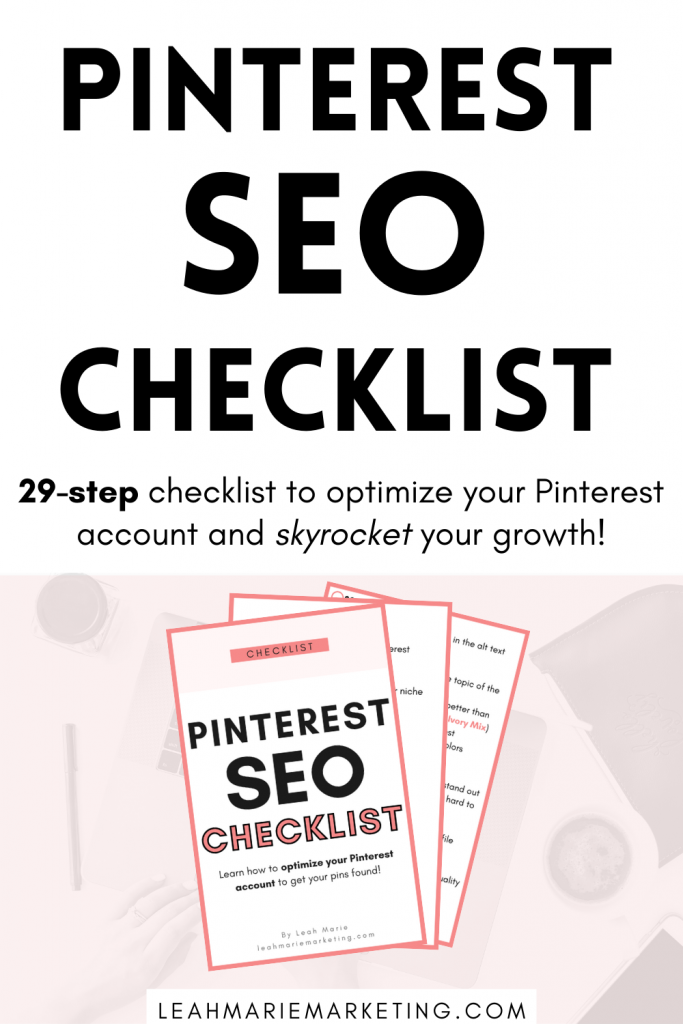
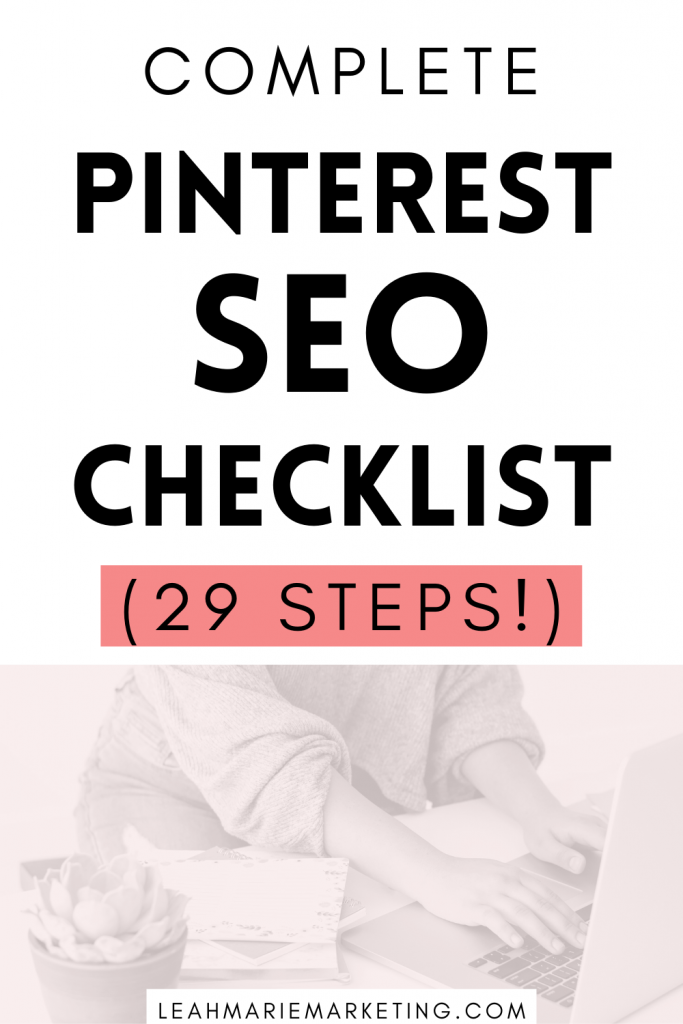




Great article. I’ve seen many giving advice but felt yours was the most comprehensive since you gave real world examples of how it’s done.
Hi Michele! Thank you so much for your kind comment. I’m so glad that you’re finding my content helpful!
Can you tell me if a pin is considered “fresh” if it has the same url as another pin? And if so, how far apart should I pin these fresh versions?
Hi Dawn!
A fresh pin is essentially a pin with a completely new pin image and a new title/description. A pin can be a fresh pin even if it has the same URL as another pin. (I constantly create new pins for the same URL!) Different people will tell you different things in regards to how long you should wait to pin the same URL. I personally try to wait at least 3 days before creating a new pin for the same URL.
Hope this helps! 🙂